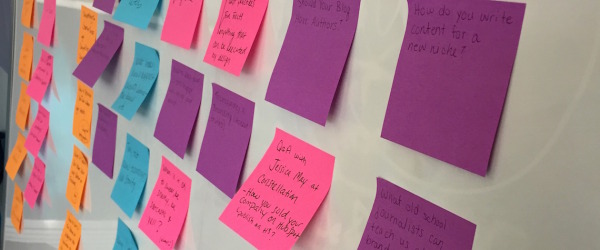
On the last Monday of every month, the Kuno Creative blog team meets to brainstorm blog topics we feel will increase blog subscriptions, drive potential buyers down the sales funnel, and delight our clients. We spend roughly 30 minutes going from person to person asking for ideas and filling in the next month’s editorial calendar with working titles. Sometimes we discuss the ideas offered in more detail, but most of the time, I type in the information one person gives and move on to the next.
By the meeting’s end, everyone knows what blogs they are supposed to write and what days they are due. And every month, we struggle to stick to the topics we put forth in the meeting or to complete our blogs on time.
Sound familiar?
If your business has an internal blog team, I bet you’ve run into this problem before. Like us, I bet you’ve tried remedying it in many different ways. For example, we reduced the number of posts each person had to contribute and set aside time to praise the blogs that received the most interest. At one point, Kuno’s content director and I even discussed the possibility of offering some form of tangible reward.
But no matter what we did, none of us seemed to put as much effort into blogging for Kuno as we would into work we were creating for clients. We all treated Kuno blogs as an afterthought, a task that could be pushed back or even ignored entirely. And then we realized to fix the problem—I mean really fix the problem—we needed to stop focusing on output and results and start focusing on the root of the problem: the blog meeting.
Why Our Blog Planning Meetings Were Failing
It all started when we found this blog from Jay Acunzo on Content Marketing Institute. Acunzo’s blog discusses why group brainstorming sessions don’t work. Of the many issues with group brainstorming Acunzo shares, this one stood out to us in particular:
“Teams are constantly stressed and distracted about the rest of their work, leading them to check laptops or refresh in-boxes rather than achieve deeper, more proactive thought and flow during the brainstorm sessions.”
Remember my description of our meetings? We’d go from person to person asking for ideas until the calendar was full. In an ideal world, we’d all give our full attention to each person until the meeting had ended. But we don’t live in an ideal world, we live in inbound marketing agency world, and in inbound marketing agency world, a coworker is always asking if you have time to chat, a client is always emailing with questions, and a new task is always being assigned.
In other words, until it was your turn, you paid close attention to the discussion, offering quality feedback on the ideas or even suggesting possible topics for the person speaking. But as soon as you had your turn and your name was on the calendar, you likely tuned out entirely, replying to emails or (gasp!) checking Facebook.
We were failing to create a brainstorming environment that fully engaged and inspired our team during blog meetings. So when it came time to write blogs, we all had to dig deep to find that inspiration ourselves. And with so much else going on, unsurprisingly, many of us couldn’t find that inspiration, which resulted in late blogs or blog topics entirely different than those on the calendar.
Our Inspiring Blog Planning Meeting
We knew to make a better blog, our next meeting needed to be different, so we took a cue from Acunzo and used sticky notes to bolster our brainstorming.
Before the meeting, we asked everyone to study his or her favorite blog. It could be industry related or a blog they enjoyed reading outside of work. Then to kick off the meeting, we asked each person to share what it is they liked most about the posts. Here’s a sampling of what was shared:
- The posts are enjoyable to read and showcase the author’s personality
- Post content is “chunked” into easy-to-digest portions
- In some posts, images are just as important (sometimes even more so) than text
- Many posts offer relatable real life examples
- The tips in posts are actionable/usable
- Many posts are emotionally charged and/or share personal stories
- Some posts offer “behind the scenes” or exclusive content
- If posts are sharing timely information, the authors intrigue readers with a new angle
Next, each person was given a stack of sticky notes. The meeting leader (in this case, our content director) informed us we had 2 minutes to write as many blog post ideas as possible (one idea per sticky note) that incorporated any of the above “likes.” Before we started, she reminded us not to worry whether an idea was good or bad—the goal of this exercise was volume. “This period of writing forces the team to actually operate alone to generate ideas, which studies show is much more effective,” says Acunzo.
When the 2 minutes ended, a volunteer read her first note, which our content director stuck to our conference room whiteboard. She asked if anyone had a similar idea. If someone did, she stuck that person’s note below the first note. If not, the volunteer read her second idea, then her third (and so on). When the volunteer exhausted her stack, we moved on to the next person and the process repeated.
Once everyone’s notes were on the board, our content director called for any additional ideas we came up with as a result of hearing others’ ideas. With those added, we discussed the ideas before us. Which did the team think were worth pursuing? Which two ideas could be combined into one? Which ideas worked better as visuals? In this way, we compiled a list of more than 20 ideas that would help us reach our goals and that we’d be excited to write about.
Did It Work? Do We Have A Better Blog?
Now I know what you’re thinking: “You came up with a bunch of ideas. So what? Did you actually see results? Is your blog better?” These are fair questions; however, seeing as we just did this experiment at the end of October and seeing as we’re not yet halfway through November, I can’t say for certain it did or did not. (Although, as an aside, everyone who was on the calendar thus far turned his or her blog in on time and stuck to the topics on the calendar.)
What I can say is this: By taking a different, more engaging approach to a meeting we knew to be ineffective (boring even), we created an environment that buzzed with creativity, collaboration and excitement. The way we see it, inspiring your internal blog team in such a way is the first step in making your blog better overall.
Have you tried making your blog better by inspiring your internal blog team? What’s proved effective? What hasn’t worked? Share your insight in the comments!
Digital & Social Articles on Business 2 Community
(362)







